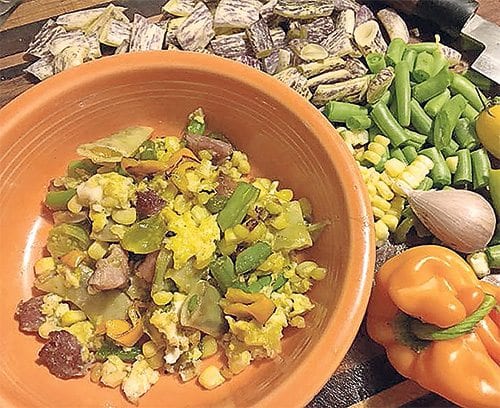
Being a child of the North, I never ate succotash. My introduction to the word came via the exasperated utterances of Sylvester the Cat, who would sputter “Suffering succotash!” when things were not going his way.
A staple of the South, succotash fed people through hardship and depression, as it did the Native Americans who invented it. The indigenous root of the name relates variously to cracked corn, boiled corn or other preparations of corn. As Native American cultures are known to have understood, when beans are added to corn, complete protein happens.
“Seaboard Algonquin” specifically, says food historian Michael Twitty, author of “The Cooking Gene,” fielding my succotash questions via Twitter. Twitty also admitted to not liking succotash very much, at least the traditional version made with lima beans.
I have to admit, I haven’t found a way to really like it myself when it’s made with lima beans, or black beans, or kidney beans, or any number of other shelling beans. Combined with the corn kernels, the dish becomes too seedy, and I much prefer making it with string beans. The protein isn’t as high, but that deficit can be erased with bacon and mayonnaise (one of my favorite healthy cooking tricks).
Twitty steered me toward a southern Louisiana version of succotash, macque choux, that does not contain shelled beans but does allow the likes of tomatoes, green bell peppers, onions, garlic and celery. And bacon, of course. And shrimp, unsurprisingly. It’s a model roughly in keeping with my own protocols, minus the shrimp.
Without the shell beans, a pan of succotash becomes like a pan of fried rice. Along with string beans and the above ingredients, one can use other veggies like collard greens, zucchini and hot, sweet and roasted peppers.
Allen Broach, who comes from an old Southern family and has fond memories of his grandma’s succotash, has given me some of my best recipes. He’s fine with people using string beans in succotash, although the closest they ever came growing up was to use “shellies,” the beans inside overgrown string beans.
Here is his family recipe, which is lima bean-based.
Grannie Smith’s succotash
Equal amounts of baby lima beans and corn cut from the cob. You should also “milk” the cob once the corn is cut off by scraping the cob with a knife to get all the juice from it.
Use bacon drippings and sauté the limas for a couple of minutes. Season with salt and pepper then add water to cover and cook until they are nearly done.
Add a small onion, diced, and the corn. Cook until the corn is done. Most of the liquid should be cooked out. Just a few minutes.
That was it.
Broach confessed to having modified grandma’s recipe by adding any number of the following to the average batch of succotash.
4 tablespoons butter
Garlic (minced)
1 cup whole grain hominy
pound cooked beef brisket or country ham, chopped
2 oz. salt pork in one piece
Salt and freshly ground black pepper to taste
1 boiling potato (about ½ pound) such as Yukon gold, boiled and diced
1 small turnip, boiled and diced
1/4 cup or so chopped red or green bell pepper (or a combination)
Among other parts of this recipe, I was intrigued by his country ham idea, so I picked one up at the farmers market, brought it home and diced it up. Into the pan it went, and as the greasy cubes sizzled pleasantly, I proceeded to prep the veggies, adding them in layers, in the order of how much cooking they need. After the meat, which sometimes includes deer meat as well as the ham/bacon, I will add the onions, then the beans, then peppers, diced zucchini, butter and olive oil as necessary, and finally the corn on top. I let it cook like this undisturbed for a while, allowing the meat at the bottom to cook in the accumulating juices.
When it’s finally time to stir, somewhere between when the veggies give up all of their moisture and when the bottom starts to burn, I add minced or grated garlic and dried thyme, and stir it up. I’ll stir again once or twice until it’s ready, and serve with cheese, parsley, salsa, roasted peppers and whatever else. Succotash, like the kitchen sink, can absorb practically anything you can throw at it.
Ari LeVaux lives in Montana and New Mexico and can be reached at flash@flashinthepan.net. Follow him on Twitter at @arilevaux.






